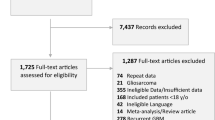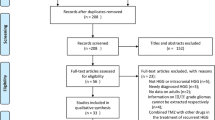Abstract
Purpose
The optimal duration of post-radiation temozolomide in newly diagnosed glioblastoma remains unclear, with no published phase III randomised trials. Standard-of-care stipulates 6 months. However, in routine care, it is often extended to 12 months, despite lacking robust supporting data.
Methods
GEINO14-01 (Spain) and EX-TEM (Australia) studies enrolled glioblastoma patients without progression at the end of 6 months post-radiation temozolomide. Participants were randomised 1:1 to six additional months of temozolomide or observation. Primary endpoint was 6-month progression free survival from date of randomisation (6mPFS). Secondary endpoints included overall survival (OS) and toxicity. 204 patients were required to detect an improvement in 6mPFS from 50 to 60% (80% power). Neither study recruited sufficient patients. We performed a combined analysis of individual patient data.
Results
205 patients were recruited: 159 in GEINO14-01 (2014–2018) and 46 in EX-TEM (2019–2022). Median follow-up was 20.0 and 14.5 months. Baseline characteristics were balanced. There was no significant improvement in 6mPFS (57.2% vs 64.0%, OR0.75, p = 0.4), nor across any subgroups, including MGMT methylated; PFS (HR0.92, p = 0.59, median 7.8 vs 9.7 months); or OS (HR1.03, p = 0.87, median 20.1 vs 19.4 months). During treatment extension, 64% experienced any grade adverse event, mainly fatigue and gastrointestinal (both 54%). Only a minority required treatment changes: 4.5% dose delay, 7.5% dose reduction, 1.5% temozolomide discontinuation.
Conclusion
For glioblastoma patients, extending post-radiation temozolomide from 6 to 12 months is well tolerated but does not improve 6mPFS. We could not identify any subset that benefitted from extended treatment. Six months should remain standard-of-care.


Similar content being viewed by others
Data availability
The data generated in this study are not publicly available as this would compromise patient consent, but are available upon reasonable request from the corresponding author.
Change history
30 January 2024
A Correction to this paper has been published: https://doi.org/10.1007/s11060-024-04581-x
References
Stupp R, Mason WP, van den Bent MJ et al (2005) Radiotherapy plus concomitant and adjuvant temozolomide for glioblastoma. N Engl J Med 352(10):987–996
Lai A, Nghiemphu TA et al (2011) Phase II trial of bevacizumab plus temozolomide during and after radiation therapy for patients with newly diagnosed glioblastoma multiforme. J Clin Oncol 29:142–148
Gruber ML, Raza S, Gruber D, Narayana A (2009) Bevacizumab in combination with radiotherapy plus concomitant and adjuvant temozolomide for newly diagnosed glioblastoma: update progression free survival, overall survival, and toxicity. J Clin Oncol. https://doi.org/10.1200/jco.2009.27.15_suppl.2017
Gilbert MR, Dignam JJ, Armstrong TS et al (2014) A randomized trial of bevacizumab for newly diagnosed glioblastoma. N Engl J Med 370:699–708
Chinot OL, Wick W, Mason W et al (2014) Bevacizumab plus radiotherapy-temozolomide for newly diagnosed glioblastoma. N Engl J Med 370:709–722
Weller M, Butowski N, Tran DD, ACT IV trial investigators et al (2017) Rindopepimut with temozolomide for patients with newly diagnosed, EGFRvIII-expressing glioblastoma (ACT IV): a randomised, double-blind, international phase 3 trial. Lancet Oncol 18(10):1373–1385
Westphal M, Heese O, Steinbach JP et al (2015) A randomised, open label phase III trial with nimotuzumab, an anti-epidermal growth factor receptor monoclonal antibody in the treatment of newly diagnosed adult glioblastoma. Eur J Cancer 51:522–532
Gilbert MR, Wang M, Aldape KD et al (2013) Dose-dense temozolomide for newly diagnosed glioblastoma: a randomized phase III clinical trial. J Clin Oncol 31:4085–4091
Roldán GB, Singh AD, Easaw JC (2012) Extended adjuvant temozolomide for treatment of newly diagnosed glioblastoma multiforme. J Neurooncol 108(1):173–177
Blumenthal DT, Gorlia T, Gilbert MR et al (2017) Is more better? The impact of extended adjuvant temozolomide in newly diagnosed glioblastoma: a secondary analysis of EORTC and NRG Oncology/RTOG. Neuro Oncol 19(8):1119–1126
van den Bent MJ, Wick TCMS et al (2021) Adjuvant and concurrent temozolomide for 1p/19q non-co-deleted anaplastic glioma (CATNON; EORTC study 26053–22054): second interim analysis of a randomised, open-label, phase 3 study. Lancet Oncol 22(6):813–823
Attia AM, Eltybe HA, Sedik MF et al (2022) The efficacy and safety of extended adjuvant temozolomide following concurrent radio-chemotherapy among Egyptian patients with newly diagnosed glioblastoma multiforme. Am J Cancer Res 12(1):355–370
Gherasim-Morogai N, Afrasanie VA, Gafton B et al (2022) Can extended chemotherapy improve glioblastoma outcomes? A retrospective analysis of survival in real-world patients. J Pers Med 12(10):1670
Wang J, Huang Y, Zhao F et al (2022) Standard or extended STUPP? Optimal duration of temozolomide for patients with high-grade gliomas: a retrospective analysis. J Neurooncol 160(2):433–443. https://doi.org/10.1007/s11060-022-04162-w
Elsaka R, Kitagwa JM, Refaat T et al (2023) Impact of extended adjuvant temozolamide beyond 6 months in the management of glioblastoma patients. Am J Clin Oncol 46(3):101–106
Chen J, Wang T, Liu W et al (2022) Extended adjuvant temozolomide in newly diagnosed glioblastoma: a single-center retrospective study. Front Oncol 12:1000501
Barbagallo GM, Paratore S, Caltabiano R et al (2014) Long-term therapy with temozolomide is a feasible option for newly diagnosed glioblastoma: a single-institution experience with as many as 101 temozolomide cycles. Neurosurg Focus 37(6):E4
Refae AA, Ezzat A, Salem D et al (2015) Protracted adjuvant temozolomide in glioblastoma multiforme. J Cancer Ther 6:748–758
Gramatzki D, Kickingereder P, Hentschel B et al (2017) Limited role for extended maintenance temozolomide for newly diagnosed glioblastoma. Neurology 88(15):1422–1430
Hsieh SY, Chan DT, Kam MK et al (2017) Feasibility and safety of extended adjuvant temozolomide beyond six cycles for patients with glioblastoma. Hong Kong Med J 23(6):594–598
Bhandari M, Gandhi AK, Devnani B et al (2017) Comparative study of adjuvant temozolomide six cycles versus extended 12 cycles in newly diagnosed glioblastoma multiforme. J Clin Diagn Res 11(5):04–08
Harris PA, Taylor R, Thielke R et al (2009) Research electronic data capture (REDCap)—a metadata-driven methodology and workflow process for providing translational research informatics support. J Biomed Inform 42(2):377–381
Harris PA, Taylor R, Minor BL et al (2019) The REDCap consortium: building an international community of software partners. J Biomed Inform. https://doi.org/10.1016/j.jbi.2019.103208
Gupta T, Talukdar R, Kannan S et al (2022) Efficacy and safety of extended adjuvant temozolomide compared to standard adjuvant temozolomide in glioblastoma: Updated systematic review and meta-analysis. Neurooncol Pract 9(5):354–363
Attarian F, Taghizadeh-Hesary F, Fanipakdel A et al (2021) A systematic review and meta-analysis on the number of adjuvant temozolomide cycles in newly diagnosed glioblastoma. Front Oncol 11:779491
Wick W, Weller M, van den Bent M et al (2014) MGMT testing – the challenges for biomarker-based glioma treatment. Nat Rev Neurol 10:372–385
Touat M, Li YY, Boynton AN, Spurr LF et al (2020) Mechanisms and therapeutic implications of hypermutation in gliomas. Nature 580(7804):517–523
Johnson BE, Mazor T, Hong C et al (2014) Mutational analysis reveals the origin and therapy-driven evolution of recurrent glioma. Science 343(6167):189–193
Yu Y, Villanueva-Meyer J, Grimmer MR et al (2021) Temozolomide-induced hypermutation is associated with distant recurrence and reduced survival after high-grade transformation of low-grade IDH-mutant gliomas. Neuro Oncol 23(11):1872–1884
Choi S, Yu Y, Grimmer MR et al (2018) Temozolomide-associated hypermutation in gliomas. Neuro Oncol 20(10):1300–1309
Balana C, Vaz MA, Manuel Sepúlveda J et al (2020) A phase II randomized, multicenter, open-label trial of continuing adjuvant temozolomide beyond 6 cycles in patients with glioblastoma (GEINO 14–01). Neuro Oncol 22(12):1851–1861
Funding
The studies were supported financially by the Victoria Comprehensive Cancer Centre (EX-TEM) and a grant from the Spanish Institute Carlos III (ISCIII: PI13/01751 to Carmen Balana) (GEINO14-01). Analysis and manuscript preparation was made possible in part through the authors’ membership of the Brain Cancer Centre.
Author information
Authors and Affiliations
Contributions
L.G., M.R., P.G, and C.B. contributed to the study conception and design. Material preparation and data collection was performed by all authors. Analysis was performed by L.G. and W.H. The first draft of the manuscript was written by L.G. and all authors commented on previous versions of the manuscript. All authors read and approved the final manuscript.
Corresponding author
Ethics declarations
Competing interests
The authors declare no competing interests.
Conflict of interest
The authors declare no potential conflicts of interest.
Additional information
Publisher's Note
Springer Nature remains neutral with regard to jurisdictional claims in published maps and institutional affiliations.
Rights and permissions
Springer Nature or its licensor (e.g. a society or other partner) holds exclusive rights to this article under a publishing agreement with the author(s) or other rightsholder(s); author self-archiving of the accepted manuscript version of this article is solely governed by the terms of such publishing agreement and applicable law.
About this article
Cite this article
Gately, L., Mesía, C., Sepúlveda, J.M. et al. A combined analysis of two prospective randomised studies exploring the impact of extended post-radiation temozolomide on survival outcomes in newly diagnosed glioblastoma. J Neurooncol 166, 407–415 (2024). https://doi.org/10.1007/s11060-023-04513-1
Received:
Accepted:
Published:
Issue Date:
DOI: https://doi.org/10.1007/s11060-023-04513-1




